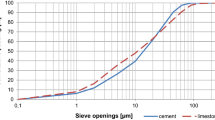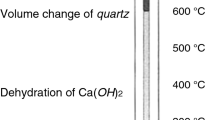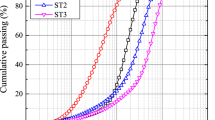Abstract
This paper examines the dimensional instability of cement bonded particleboard (CBPB) and discusses the behaviour of CBPB during cyclic changes in relative humidities (RH). The results indicated that the changes of CBPB in both mass and dimensions reflected the changes in RH; in a cycle 90–65–35–65–90%RH the change of per percentage change in RH was 1.0:1.3:1.3:2.5 for mass, 1:2:2:1 for length and 1.3:1.1:1.0:1.0 for thickness. The changes were closely related to the structure of CBPB and the nature of the cement paste and wood chips. Thickness change was double that of the length change between 65 and 35%RH and triple that between 65 and 90%RH. The rate of change in mass was much higher than that in dimensions. The hysteresis loops were dissimilar to those of other wood and wood-based materials, with the loops of mass change closed between 65 and 90%RH, while the loops for dimensional changes were open. A set of the former loops moved upward and the latter moved downward with increasing number of cycles, corresponding to an accumulated increase in mass, but decrease in dimensions. The models developed for CBPB under constant and a single changing RH were successfully applied to changes under cyclic RH.
The sorption behaviour and dimensional movement of CBPB has been shown to be influenced not only by RH, but also by its intermediate history, with the maximum values for change within every phase of sorption, in both mass and dimensions, being higher for the cycling between 35–90%RH than the cycling regime 35–65–90%RH. The ratios of dimensional changes to mass change of CBPB were greater under the latter regime than under the former regime.








Similar content being viewed by others
References
Czernin W (1980) Cement chemistry and physics for civil engineers. Bauverlag Gmbh, Wiesbaden
Dinwoodie JM (1981) Timber: Its nature and behaviour. Van Nostrand Reinhold, Wokingham, England
Fan MZ (1997) Dimensional instability of CBPB: Understanding its occurrence and reducing its magnitude. University of Wales
Fan MZ, Dinwoodie JM, Bonfield PW, Breese MC (2002) Dimensional instability of CBPB, Part 1: Behaviour and modelling prediction under constant and single changing RH. Wood Sci Tech 36:125–143
Feldman RF, Sereda PJ (1963) Compacts of powdered material as porous bodies for use in sorption studies. J Appl Chem 13:150–158
Feldman RF, Sereda PJ (1964) Sorption of water on compacts of bottle-hydrated cement. J Appl Chem 14:87–93
Feldman RF, Sereda PJ (1970) A new model for hydrated Portland cement and its practical implications. Eng J 53(8/9):53–59
Goldstein IS (1977) Wood technology. In: Symp Series 43. Amer Chem Soc, Washington DC
Helmuth RA, Turk D (1970) The reversible and irreversible drying shrinkage of hardened Portland cement and tricalcium silicate paste. J PCA Res Dev Lab, May
Illston JM, Dinwoodie JM, Smith AA (1979) Concrete, timber and metals. Van Norstrand Reinhold, Wokingham, England
Ishai O (1968) Drying shrinkage mechanism in hardened paste and mortar. Appl Mater Res 5(3):154–161
Kollmann FP, Côté WA (1968) Principles of wood science and technology, Part 1: Solid wood. Springer, Berlin Heidelberg New York
Peralta PN (1995) Sorption of moisture by wood within a limited range of relative humidities. Wood Fiber Sci 27(1):13–21
Powers TC (1959) Capillary continuity of discontinuity in Portland cement paste. PCA Bulletin 10:2–12
Powers TC, Brownyard TL (1948) Studies of the physical properties of hardened Portland cement paste. In: Report Res Lab PCA
Rao JS (1941) Ink bottle theory. J Phys Chem 45:517
Rowell RM, Youngs RL (1981) Dimensional stability of wood in use. Research paper, For Prod Lab, USA
Skaar C (1972) Water in wood. Syracuse University Press
Skaar C (1988) Wood–water relations. Springer, Berlin Heidelberg New York
Soroka I (1979) Portland cement paste and concrete. Macmillan, Basingstoke, England
Swenson EG, Sereda PJ (1968) Mechanism of the carbonation shrinkage of lime and hydrated cement. J Appl Chem 18:111–117
Urquhart AL (1960) Sorption isotherms. Textile Book Publishers, New York
Author information
Authors and Affiliations
Corresponding author
Additional information
The senior author wishes to thank Professor W.B. Banks of University of Wales, Bangor for his constructive discussions and assistance and the British Council for partly financial support.
Rights and permissions
About this article
Cite this article
Fan, M.Z., Dinwoodie, J.M., Bonfield, P.W. et al. Dimensional instability of cement bonded particleboard. Wood Sci Technol 38, 53–68 (2004). https://doi.org/10.1007/s00226-003-0208-2
Received:
Published:
Issue Date:
DOI: https://doi.org/10.1007/s00226-003-0208-2




